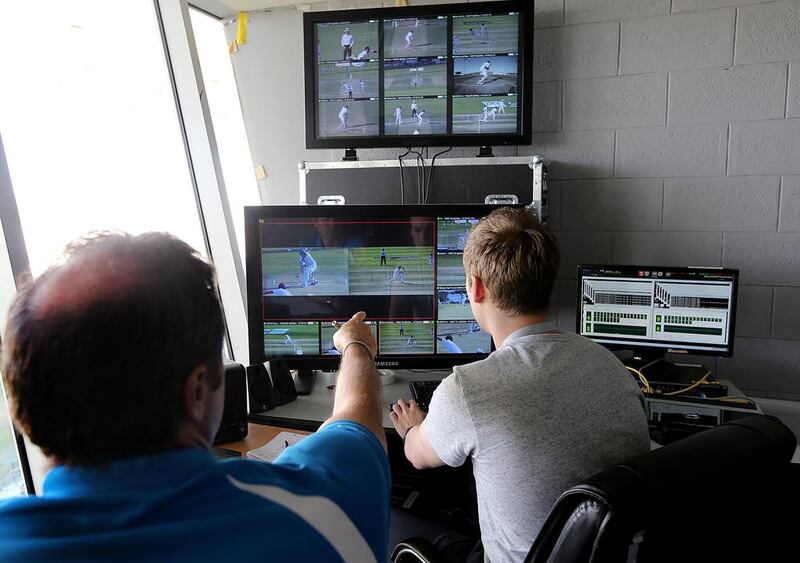Inside a small room at the Zayed Cricket Stadium in Abu Dhabi, big things are happening.
Simon Taufel, the former umpire, and widely acknowledged as one of the best, is sitting in one corner.
To one side of him are two small screens and on his right, as he faces the window overlooking the field, are two massive flat-screen monitors.
Sixteen television feeds are available on the giant monitors, all tapped into the different camera angles the official broadcaster is providing. The operator handling those feeds, sitting next to Taufel, is effectively his TV director.
Over the course of this Test, this little room is ground zero for cricket and cricket broadcasting’s continuing dance with technology. The Officiating Replay System (ORS), which is what this little experiment is known as, is being trialled through the Test series.
Potentially, it could revolutionise the role of the TV umpire and perhaps the role of technology and the Decision Review System (DRS) itself.
The mechanics are this: Taufel, now the International Cricket Council (ICC) training and performance manager for umpires, can access whatever replay he wants, from all the feeds in front of him – say, a front-foot no-ball or a boundary call – instantly from the operator sitting next to him.
Right now, the actual TV umpire has access only to the live feeds and replays that we, the TV viewers have.
Every time a decision is referred to him from the on-field umpire, he has to request the replays from the TV director of the broadcast.
He is shown one angle at a time, as we are; Taufel, effectively a shadow TV umpire for this Test, can call up multiple angles of the same incident on split screens.
His replays are in high-definition, unlike those of the actual TV umpire in this Test, Sundaram Ravi.
Fortuitously, an ideal example of the kind of change ORS can effect appeared immediately. Bilawal Bhatti dismissed Mahela Jayawardene after lunch on the first day.
The on-field umpires asked Jayawardene to hold on to check a front-foot no-ball.
Their caution proved well-founded. It was a no-ball and Jayawardene was reprieved.
Except that it took between 35-40 seconds for the communication between the on-field umpires and the TV umpire, and then some more time after that to confirm it was a no-ball. Inside the ORS, Taufel had seen and mock-communicated a confirmation within five seconds.
Saving time on replays is a major advantage.
“It’s a very efficient way of being able to look at replays and avoid communication issues,” Taufel said.
“If I can do a boundary check in five seconds, normally for a third [TV] umpire to go through to a director and then he shows a replay, will take roughly 30 seconds. It’s a huge difference in that respect.
“Even a front-foot no-ball check, I could probably do that in two seconds even before the batsman leaves the square I have an answer for the umpire.
“That could take 30-40 seconds because the director is focused on something else, his broadcast; we’re focused on our decision-making.”
It also, as Taufel acknowledges, gives the TV umpire far greater control, theoretically improving the accuracy of decision-making: that has always been one bone of contention for DRS-sceptics, that broadcasters ultimately have control over the process and, in theory, could impose biases on it.
This is, however, only at a trial stage. Taufel’s work has no impact on the actual officiating of this series.
The path from here to a stage where ORS is being implemented in international cricket is long and especially thorny.
For one, the workload on a TV umpire, already considerable, will be immense. Taufel was a whirl of ceaseless activity and multiple checks on every single delivery inside the ORS.
The cost of operating it will also be a critical factor, not only the sums involved, but whether it is worth doing if, ultimately, it is adding just 1-2 per cent to the percentage of decisions umpires and the DRS already get correct.
“There’s three things we’re trying to get out of this,” said Geoff Allardice, the ICC’s general manager of cricket.
“One is quicker decisions from TV umpires. If we can provide him with more information to make better decisions, that’s another thing.
“The one for us in the long term is does it still make good TV? The theatre of watching a decision unfold in front of a TV viewer or a person at the ground is part of DRS at moment: can we replicate that if the umpire has control of his own pictures?
“We’re encouraged with what we’ve seen so far. We want to get to the end of this game and make sure we’ve got all the information we need from the trial and then we take the next step.”
osamiuddin@thenational.ae
Follow us on Twitter at SprtNationalUAE





